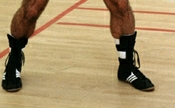
Timing your boxing footwork effectively to get in and out of range.
I’ve known this for a long time but never thought about sharing it online until I saw a friend getting hammered last Friday during an intense sparring session. Basically, his opponent was a bigger guy chasing him down and landing big shots. My friend was doing all he could to keep moving and maintain a gap between him and his opponent but his “constant movement” wasn’t enough to keep his opponent off of him. I figured some of you might want to know what I said to my friend in between rounds.
Use Boxing Footwork To Go In & Out
The point of having good boxing footwork is to go in and out. Don’t waste your legs and footwork skills by just plodding forward all the time or running away all the time. The point of “footwork” is to use your legs to go in all directions and changing directions as needed. At the very minimum, you should use boxing footwork to get yourself IN & OUT of punching range and use hit & run tactics all the time.
Timing Your Boxing Footwork
You should always time your boxing footwork so that you are moving when your opponent is punching AND punching when your opponent is moving. If you think carefully about what I just said, you’ll realize that this means your opponent is doing the same thing you are…so what’s the difference? You are trying to use your footwork so that you are punching when your opponent is moving in whereas your opponent is punching as you’re moving away.
How To Move In & Out
- CREATE SPACE – When he starts to punch, step back and create some space. You want to backstep just enough to be out of range and make him hit air. Again you’re NOT running, you’re just making space.
- IN & PUNCH – Right as he’s finished punching (won’t be long since you’re out of range), quickly STEP IN and throw some punches. Chances are, he probably stopped punching and started chasing you when you jumped in and caught him with his feet off the ground.
- REPEAT Step1 – You’ve stopped his forward momentum by landing some punches and he’s finally found his footing and started throwing back counter-punches but it’s too late because you already created space again.
- REPEAT Step2 – He realizes the counter-punches are too late and right as he stops punching you have once again slid into range and threw more punches.
What To Do When He Catches On
I actually find this to be a funny situation when your opponent catches on to your hit & run tricks. He’s most likely going to get frustrated and do either one of two things:
- He’s stands still – He’ll stop moving and decide to wait for you instead. If he does this, just throw some hand fakes and foot fakes to get him to counter-punch first or move first and then come in and hit him with some shots before backing out again. You can also use this opportunity to calmly circle around him to catch your breath if you need.
- He runs away – He realizes you have superior footwork and he doesn’t know how to come into you so he starts running away or circling you defensively. At this point, you just have to walk him down with cautious jabs and force him to waste energy running away from you. At some point, he’ll give up all of his ground and be backed helplessly into a corner.
Examples of Good In & Out Boxing Footwork
- Manny Pacquiao sparring – He’s a monster at going IN & OUT. This sparring session was years ago and his opponents can’t tell when he’s coming or going. Manny Pacquiao Boxing Footwork
- Joe Calzaghe VS Mikkel Kessler – His fight against Mikkel Kessler is a great example of IN & OUT boxing footwork.
- Oscar De La Hoya VS Felix Trinidad – Beautiful display of perfectly timed in & out footwork. You’ll see Trinidad pulling back his punches because Oscar had already backed out. The young Oscar had great legs.
Final Thoughts On Boxing Footwork
Boxing footwork is meant to carry you in all directions AND with timing. When you use footwork to retreat, you should always be retreating with the attitude of eventually advancing forward to land shots. It’s the same idea as when you are defending against punches with the intention of ultimately throwing some of your own. Vice versa, you shouldn’t always be plodding forward just as you shouldn’t always be throwing punches. As for timing: you should always use timed footwork. There’s no point in just bouncing back and forth wasting energy with no meaning. You should be moving in with a purpose and moving out with a purpose. Simply bouncing around a heavy bag all day doesn’t make you a boxer with good footwork.
When boxing footwork is properly combined with timing, you will control the pace and momentum of the fight. You control the range and when you want to punch. Boxing footwork is a beautiful skill to master and becomes a requirement at the higher levels of boxing competition!
As you get better, you can learn how to circle your opponent which is an even more advanced way of keeping yourself always within range while your opponent is out of range because he isn’t facing you. It requires less energy but definitely more skill, reflexes, and training. At the same time, circling your opponent will give you many new angles of attack.
Other guides on boxing footwork:





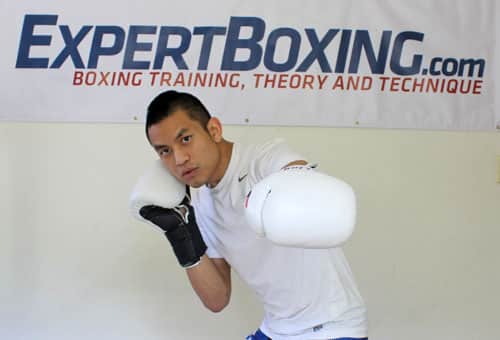

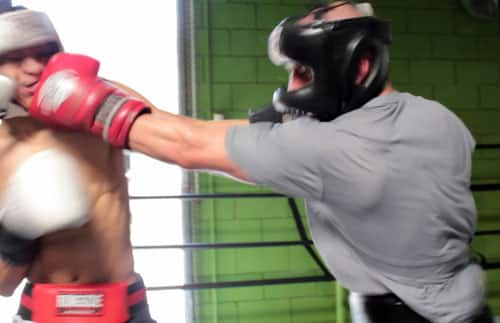
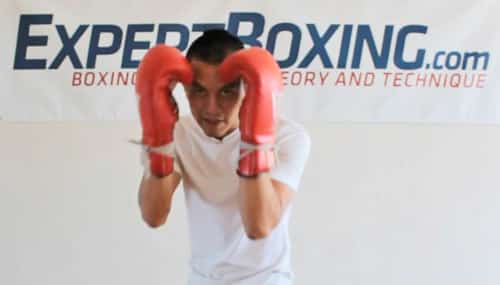

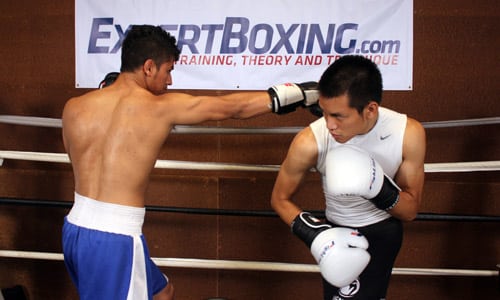
foot
Nice work Rado. The external links are really helpful and add a lot of value to the site. It can be hard finding visual examples of what you are describing, so any extra help is great.
thanks for this tip on footwork coz i was sparring a friend and i was out of reach i could land only kand a few punches and i didnt realize hi coming in and out wat u describbed thanks alot
Hey, I appreciate all these articles, they’re all damn useful, and very well written!
How do I apply the step-in/step-out when my opponent is just going on a straight charge forward? Would it not be better to step to the side out of the path of his punches and land some of my own from an angle?
stepping out at an angle instead of just stepping straight back during a fight
Hi Ross,
Stepping out to the side is a more advanced maneuver. I don’t recommend it with beginners because they don’t usually have the confidence to do it properly. if you sidestep incorrectly, your head will STILL be in range and you can easily get hit during wild brawls. Stepping back entirely requires more energy and definitely pulls you out of range (especially against other wild-swinging brawlers).
As for stepping in & out against forward-charging brawlers…the idea is simple. You stand there, they come… you quickly back up making space as they swing at the air. You quickly close the gap and bring yourself into range as you throw your own punches… and then back up again. Sometimes, the easiest way to stop a brawler’s forward movement is to charge back into HIM! The difference is that you don’t stay there and get sucked into his fight game. I’m sure you’ve heard of professional boxers before that believe in beating swarmer fighters by backing them up since they probably can’t fight going backwards.
hey great advise is there any footwork drills i can do to improve my allround movement? or anything in the mirror? cheers
footwork drills
Hi Jim,
I’m coming up with an article on that soon. There’s a lot of small specifics and details (as is always the case with my articles) and I’ll have it up soon.
In the meanwhile, just make sure that when you move your body around that it is “sliding” and not “jumping”. You want to be careful that your steps don’t throw you off balance and that you relax your lower body just as you do with your upper body.
ok thanx man my mobility is a general problem that i realy struggle with
When they move foward with punches and you move back do you wait until they are done punching THEN step back in and punch or do you do it like in the middle of there combination or as they are punching? for example if they are throwing a jab cross do you move back from the jab then step back in and throw before the cross or do you wait until their combo is done then step back in and fire? Basically my question is do you step back in when they are done throwing or in the middle of them throwing and stepping in?
punching with movement
Hi Travis,
Yes, you move back and then interrupt their punches with counters right in the middle of their combination. The “trick” is that right as you’re out of range, they will subconsciously notice and start to pull back on their punches… which is right about when you’re back in their face with a hard counter already. You can’t be thinking about it in the heat of the fight; you just have to “trust” that their combinations will stop once you’re out of range.
Punching while moving
I have a question concerning punching while moving forward. I’ve been told to throw a 1-2 combo while coordinating my left foot moving forward with the left jab, right foot forward with the right hand. I’ve also heard that this is bad and that the right foot should stay grounded when you throw the right hand. Being shorter, the first way seems to be good for covering ground, but at the expense of power. What do you think? Thanks.
1-2 while moving
Hi Gordon,
You ask a great question that a lot of beginners don’t know. There’s 2 ways to throw that 1-2 while moving without sacrificing power:
First method: throw the jab as you step forward with your front foot, then step the back foot up, now with both feet planted you can pivot with the back foot HARD into the cross
Second method: step the front foot forward first, then throw the left jab as you step the back foot up, now with both feet planted you can pivot with the back foot HARD into the cross
The first method uses the STEP JAB. The second method uses the POWER JAB. You can read more about these jabs here: https://expertboxing.com/boxing-training/punching-techniques/114-5-types-of-jabs
Try them both and see which one works better for you.
Thanks, Johnny. This is going to take some practice.
Throwing the 1-2
I’ve never been told to throw a 1-2 combination the way you desrcribed it to Gordon. I have always stepped in with the jab and then thrown my cross without ever moving the back foot until after the combination is done. I’ve seen other coaches teach it that way. It seems much faster this way and it has always worked for me. It seems to me that, if you throw it in the way that you describe, there is a short pause between the jab and the execution of the cross. Waiting for the back foot to move up before throwing the cross seems to “interrupt” the combination. I have tried it, and it seems much less fluid than the way I have been doing it. Is my way technically flawed in some way? If so, I will adopt your method of throwing the 1-2 if my way is wrong.
@Greg – You ask a great question, and many boxers either don’t notice the difference or don’t care. Planting the right foot before the right hand is thrown ensures maximum power. If you slide in with the 1-2 then you will be able to cover ground and have a smoother transition. I believe Thomas Hearns prefers the sliding method. There is another way to move in and ensure maximum power. That is to move the front foot first, then throw the jab as the back foot slides up. Because the back foot moved up with the jab, it is ready to immediately throw the right hand right after. A good example of a pro throwing backfoot jabs is Mayweather. Many boxers like to test the ground with the front foot first and only when they feel safe, they slide the backfoot in with a jab.
Of course you could also skip all this and just carefully walk into range and throw a stationary 1-2.
i have a question, what is better to step out, and then step in to counter punch, or slip to the outside of the punch and counter, i’m guessing against swarmers that pressure you constantly it’s better to step back… but i really want your oppinion on this.. thanks
@Lazar – this is really a question about style. What your style is and what you like to do. For me personally, I only like running if I feel like it frustrates and tires out my opponent. Otherwise, I don’t usually mind just slipping. I always use a little of both slipping and footwork, and I try to keep switching up the rhythm so he doesn’t know when to commit to his punch. For sure, counter punches usually work better when you take a step out. If I got faster hands on the inside, I don’t mind trading flurries and bunches of punches on the inside.
ok, thanks… i have one more question for you, and i hope for a detailed answer, how to be a very effective counter puncher?? How to get into position for counter punching, is it better to counter to the body, or head…. thanks for your time.
i forgot to tell you, i’m a southpaw.
Lazar – I have guides coming out for that! But for the meanwhile, I’ll explain it easy like this:
The best way to counter punch is not to wait for the punch but to force the punch. In other words, if you want to counter his right hand, don’t wait for his right hand, but force him to throw the right hand. How you force him to do that will be explained in the guide!
brilliant stuff dude! well explained the penny really drops! anymore info on footwork will b truley welcomed!
@dan williams – more awesome footwork stuff to come. I have to record so much footage but it’s coming, I promise!
exellent! cant wait for the videos! theyre really informative! keep up the good wrk man! this site really helps to make certin aspects of boxing much more clear and concise! v.kind of u to share your information.
Great article, Johnny. Having been on the receiving end of this, I know it certainly works. You mention the humorous moment when the opponent half realizes what’s going on and kind of freezes; well, I’ve been that guy, and it ain’t no fun at all. I swear the guy was smiling at me when he noticed. I stood there like a lemon, and he just swatted me with jabs, like a cat with a mouse. When I asked him after, he said timing and distance, but was unable to break it down further ( live in Japan, and my Japanese was poor at the time). It’s great to see it broken down in English here, a great help. Now at least I know what I have to practice. Thanks for all your work, mate.
Kay
what kind of footwork does a edge of range (not quit close range) body puncher need?
Johnny,
How about disrupting your opponent’s combos? I feel like I get sucked into a back and forth game all too often, any suggestions or specific guides you wrote pertaining to this?
I hope all is well and 2012 is starting strong for you bro! Thanks!
– Ron
Easy answer, tough explanation. You break your opponent’s combos by using proper counters. Are you losing the battle on footwork or punching exchanges?
https://www.youtube.com/watch?v=X9aEURJrgpw&feature=related what do you think of willie pep’s footwork? I think its brillant. What’s your opinion?
Willie Pep’s footwork is very good. He’s rightfully one of the slickest guys ever in boxing.
this is great for footwork manny pacman does this as well
https://www.youtube.com/watch?v=B_bbBglPGHA
Thanks for the fun video, I tried some of those in my room just now.
have you noticed a workout? or thorough movement in your footwork?
Can i still practice footwork on the bags (double end bag heavy bag etc?)
Yes, that’s a good idea.
after re-reading this article i noticed this is somewhat the “drowning technique” you have written
Johnny, will you be writing an article in the near future about the advanced footwork technique where you are circling around your opponent and how to train to achieve it. If so, it will definitely be a very interesting read. 🙂
Hi Mike, this won’t be for a couple more months. Feel free to email me personal requests. I do create youtube videos faster than writing articles.
No problem johnny. I’m returning to box shortly and I’m confident in getting a few wins after spending months mastering all your tips. Your article on getting in and out of range, moving while he’s punching, punching while he’s moving etc. really elevated my game. 🙂
Tht,s true.in fight the ftwork is the key to victory.strikes is just the part of the game.how u cn win the fight while u just know how to strike and doesn,t know how to use u footwork(moving out and get inside) ifthe strike is the key to win a fight,and tht for sure in any fighting sports the one who hve the hrd punch or strong physicall is must be the one who dominent the all kind of fighting sports.in my opinion,moving out is not impotant but is when to get inside is the important thng..and i thnk to get inside the opponent striking range in mean to strike is must be timing perfectly to mke sure the fighter hve the time to get out in safe position.nd the prfct tming is when the opponent is doesn,t hve another otion but to action dfnce or gting hit.ndso do the sme thng when we get in dfnsive (get out from attck) manner..in evry oponent striking,there must be some space to get inside.nd to lead this footwork perfectly effective ,this mst be combine with body mvment.
BRILLIANT article, as always sir!
Yes Johnny I have a few questions,
does your style change or do you just fight the same style with all fighters ie taller/shorter/same height. ?
And have you practised all the different styles ie Philly shell, out boxing, high volume etc etc …
Also I find the angles very complicated, there always has to 1 opening or another lol
And the way some guys well they don’t side step they mix a side step/pivot ….
I dunno, at 30 years can you teach an old dog new tricks ? Lol I just feel whatever I do some 1 with a sharper brain can see me coming (i feel safer and tighter and can see more shorts when im close … I never feel like I have range even on shorter fighters)
Give us tips bro
Thanks
For sure you have to adapt. And definitely if you’re losing the fight. I don’t know that I’ve practiced every single style there is out there but it’s never too late to learn. Keep working!
Thanks man your site is great. New to the sport and was sparring someone a lot more experienced and used this fairly well to get a few cheeky ones in and cause him a lot of frustration haha 🙂